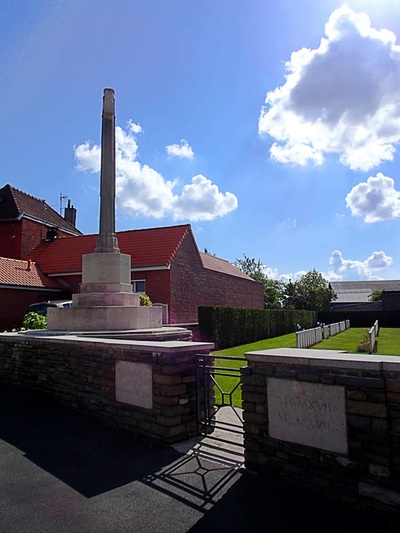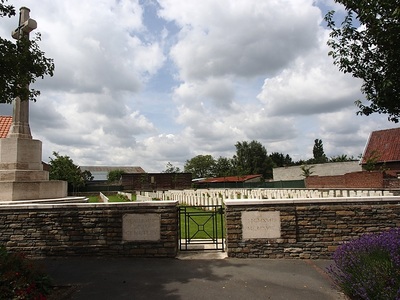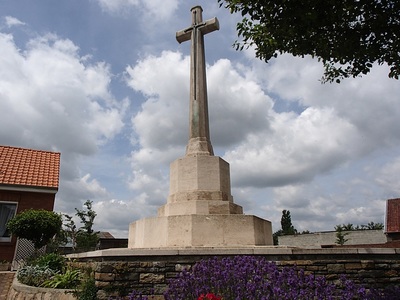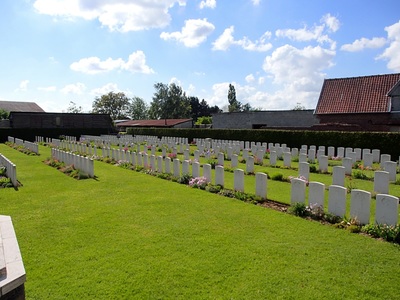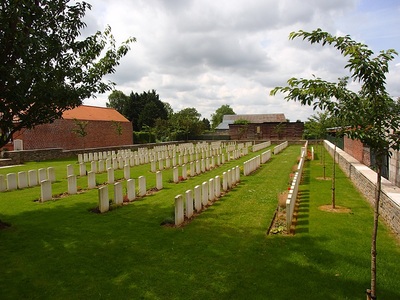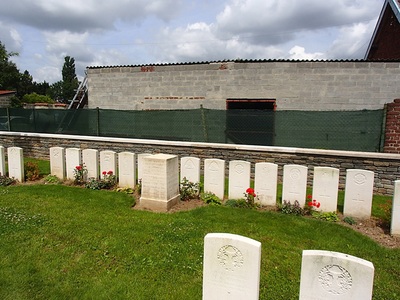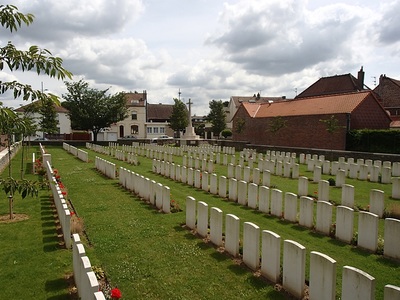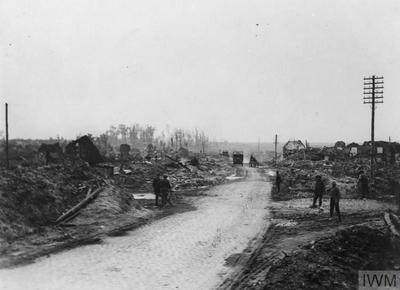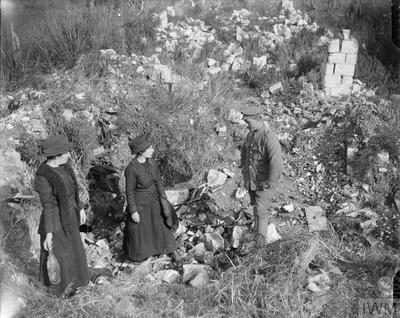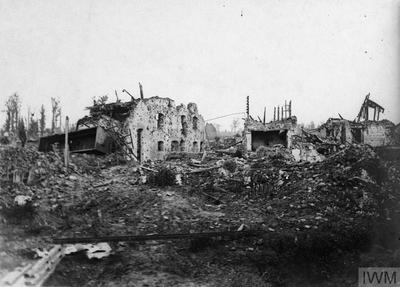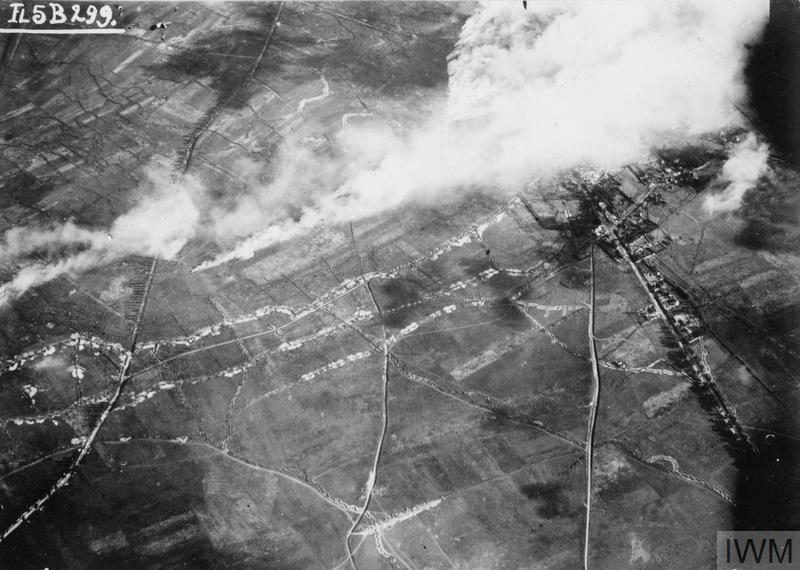BEAURAINS ROAD CEMETERY
Pas De Calais
France
GPS Coordinates: Latitude: 50.27061, Longitude: 2.78416
Location Information
Beaurains is a village on the southern outskirts of Arras, and Beaurains Road Cemetery is just north of the village on the road from Arras (N17).
Historical Information
The cemetery was begun a few days before Beaurains was captured by Commonwealth forces on 18 March 1917. It was a month before the Battle of Arras began, and the Germans were still in nearby Tilloy-les-Mofflaines. The cemetery was used (sometimes under the name of Ronville Forward Cemetery) until the beginning of June by the 14th (Light) Division Burial Officer and by fighting units. It was used again for a short time in August and September 1918, in the Second Battle of Arras. It contained, at the date of the Armistice, the graves of 129 British soldiers, 15 French soldiers and four German prisoners. It was enlarged after the armistice when graves were brought in from the surrounding battlefields and the following cemeteries:-
RONVILLE BRITISH CEMETERY was among the houses in the Faubourg St. Sauveur, a little south of the Bapaume road. It was used from April to July 1917 (when most of the burials were made by the 20th King's Royal Rifle Corps), and by the 141st Field Ambulance in August and September 1918. It contained 179 Commonwealth burials.
RONVILLE FRENCH CEMETERY adjoined the British Cemetery. It was used by Commonwealth troops from February to April 1917 and again in August 1918. It contained 26 burials.
The cemetery now contains 331 Commonwealth burials and commemorations of the First World War. 23 of the burials are unidentified and there are special memorials to 14 casualties buried in Ronville British Cemetery, whose graves were destroyed by shell fire. The cemetery also contains four German graves.
Total Burials: 335.
Identified Casualties: United Kingdom 294, Canada 14, Germany 3. Total 311.
Unidentified Casualties: United Kingdom 23, German 1. Total 24.
The cemetery was designed by Sir Edwin Lutyens and George Hartley Goldsmith
Images in gallery below © Johan Pauwels

Lieutenant
Herbert George Andrews
16th Bn. Middlesex Regiment
19th April 1917
Row B. 2.
Husband of Dorothy Andrews, of Meads Place, Eastbourne, Sussex.
His headstone bears the inscription "In Christ Shall All Be Made Alive"
Herbert George Andrews
16th Bn. Middlesex Regiment
19th April 1917
Row B. 2.
Husband of Dorothy Andrews, of Meads Place, Eastbourne, Sussex.
His headstone bears the inscription "In Christ Shall All Be Made Alive"

Lieutenant
Henry Stanley Tempest Bullen
"D" Battery, 251st Brigade
14th April 1917, aged 20.
Row E. 37.
Second son of Edith Bullen, of 27, Hawthorn Rd., Gosforth, Northumberland, and the late Tempest C. Bullen.
Henry Stanley Tempest Bullen
"D" Battery, 251st Brigade
14th April 1917, aged 20.
Row E. 37.
Second son of Edith Bullen, of 27, Hawthorn Rd., Gosforth, Northumberland, and the late Tempest C. Bullen.

Second Lieutenant
Percy Blezard Duckworth
15th (Warwick) Brigade, Royal Horse Artillery
9th April 1917, aged 23.
Row A. 23.
Son of Thomas and S. Elizabeth Alice Duckworth, of Bank House, Barbourne, Worcester.
His headstone bears the inscription "The Path Of Duty Was The Way To Glory"
Percy Blezard Duckworth
15th (Warwick) Brigade, Royal Horse Artillery
9th April 1917, aged 23.
Row A. 23.
Son of Thomas and S. Elizabeth Alice Duckworth, of Bank House, Barbourne, Worcester.
His headstone bears the inscription "The Path Of Duty Was The Way To Glory"

Second Lieutenant
Gilbert Fairley
1st Bn. Royal Scots Fusiliers
9th April 1917, aged 19.
Row B. 24.
Son of George and Margaret Anne Buchanarl Fairley, of 306, Bath St., Glasgow.
Gilbert Fairley
1st Bn. Royal Scots Fusiliers
9th April 1917, aged 19.
Row B. 24.
Son of George and Margaret Anne Buchanarl Fairley, of 306, Bath St., Glasgow.

47277 Private
Cecil Stewart Glover
12th Bn. West Yorkshire Regiment (Prince of Wales's Own)
9th April 1917, aged 19.
Row G. 43.
Son of William and Janet Glover, of 9, Brudenell Rd., Hyde Park, Leeds.
Cecil Stewart Glover
12th Bn. West Yorkshire Regiment (Prince of Wales's Own)
9th April 1917, aged 19.
Row G. 43.
Son of William and Janet Glover, of 9, Brudenell Rd., Hyde Park, Leeds.
Images in this gallery © Geerhard Joos

Major
Hero Wilhelm Oswald Hillerns, Mentioned in Despatches
"B" Battery 251st Brigade, Royal Field Artillery
14th April 1917, aged 35.
Row E. 38.
Son of Oswald and Hedwig Hillerns, of Fairway, Dissey, Cheshire. Native of Hessle, Yorks.
His headstone bears the inscription "His Memory Liveth For Evermore"
Hero Wilhelm Oswald Hillerns, Mentioned in Despatches
"B" Battery 251st Brigade, Royal Field Artillery
14th April 1917, aged 35.
Row E. 38.
Son of Oswald and Hedwig Hillerns, of Fairway, Dissey, Cheshire. Native of Hessle, Yorks.
His headstone bears the inscription "His Memory Liveth For Evermore"

39990 Private
Joshua B. Hodgson
6th Bn. King's Own Yorkshire Light Infantry
12th March 1917.
Row C. 24.
He left a widow (Averilda nee Chapman) and a daughter Esther Tweedale Hodgson. He lived in Sheffield, was born in Cleckheaton, West Yorks. son of Joshua and Esther Hodgson. Son-in-law of Mrs. M. A. Chapman, of 82, Bates St., Steel Bank, Sheffield.
Picture courtesy of Gordon Hodgson, great nephew of this soldier
Joshua B. Hodgson
6th Bn. King's Own Yorkshire Light Infantry
12th March 1917.
Row C. 24.
He left a widow (Averilda nee Chapman) and a daughter Esther Tweedale Hodgson. He lived in Sheffield, was born in Cleckheaton, West Yorks. son of Joshua and Esther Hodgson. Son-in-law of Mrs. M. A. Chapman, of 82, Bates St., Steel Bank, Sheffield.
Picture courtesy of Gordon Hodgson, great nephew of this soldier

Second Lieutenant
George Arthur Nicholls
95th Bde. Royal Horse Artillery and 15th (Warwick) Bde. Royal Horse Artillery
9th April 1917, aged 22.
Row A. 27.
Son of Horace W. and Florence Nicholls, of 9, Amherst Avenue, Ealing, London. Educated at Steyne School, Worthing, and Berkhampsted School. Born at Johannesburg, South Africa.
His headstone bears the inscription "He Always Played The Game"
George Arthur Nicholls
95th Bde. Royal Horse Artillery and 15th (Warwick) Bde. Royal Horse Artillery
9th April 1917, aged 22.
Row A. 27.
Son of Horace W. and Florence Nicholls, of 9, Amherst Avenue, Ealing, London. Educated at Steyne School, Worthing, and Berkhampsted School. Born at Johannesburg, South Africa.
His headstone bears the inscription "He Always Played The Game"

43382 Private
Charles Sinclair
1st Bn. Gordon Highlanders
9th April 1917, aged 25.
Row F. 27.
Son of William and Barbara Sinclair, of Burgess St., Lerwick, Shetland.
His headstone bears the inscription "Jesus Only"
Charles Sinclair
1st Bn. Gordon Highlanders
9th April 1917, aged 25.
Row F. 27.
Son of William and Barbara Sinclair, of Burgess St., Lerwick, Shetland.
His headstone bears the inscription "Jesus Only"

772181 Private
Waldron Watson Wallace
3rd Bn. Canadian Machine Gun Corps
4th September 1918, aged 28.
Row A. 19.
Son of Mr. and Mrs. John Wallace, of Paris, Ontario.
His headstone bears the inscription "Greater Love Hath No Man Than This"
Waldron Watson Wallace
3rd Bn. Canadian Machine Gun Corps
4th September 1918, aged 28.
Row A. 19.
Son of Mr. and Mrs. John Wallace, of Paris, Ontario.
His headstone bears the inscription "Greater Love Hath No Man Than This"


